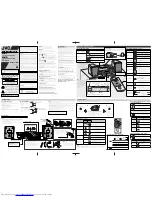
asterisks in the S(tereo) display, for example:
S +00.1* 56 Hz*
An asterisk indicates that there is a different setting between the left and
right channels. This way you can instantly inspect if the left and right channels are
identical. Just look for the asterisk to see if either frequency or level are different
between channels. In the S display, you can set both channels to the same
frequency (overriding any individual settings), without altering their level
differences, as long as the asterisk remains next to the level in the S display. The
equalizer buttons return to the display mode last used (Stereo, left or right), and the
current channel display is also saved in the presets. For example, if you’ve been
concentrating on the left channel of band #2, that is the way it will first display
when you press that band, if it has been saved that way in a particular preset.
The other bands:
High Shelf: The top right button is the high shelf, and performs exactly as
above for stereo (ganged), or individual left or right equalization. The frequency
knob controls the frequency above which action occurs.
Parametrics: Press any of the remaining four buttons, to see:
S -00.2 70 Hz Q = 0.5
As always, the label is above its corresponding knob, and as above, pressing the
button sequentially will allow you to control the Left or right channel separately.
There may be up to three asterisks in the S(tereo) display to indicate if the level,
frequency, or Q differs between left and right channels. Gang both channels
instantly by moving any control knob until the asterisk is eliminated.
Q is the inverse of bandwidth. It is the product of center frequency divided by
the 3 dB down bandwidth. Thus, a Q of 0.5 produces an extremely wide curve and
will be rarely used. A Q of 0.6 or 0.7 corresponds with the bandwidth of a typical
midrange EQ in an analog equalizer.
Specifications
•
Input/Output: AES/EBU (transformer-isolated, 110-ohm terminated)
• Input/Output precision: up to 24 bits
• Gain control: from -95 dB to +12 dB
• Gain resolution: 0.1 dB increments between 0 and 3 dB (gain or loss), 0.2
z-q2 Operations Manual version 1.0 1/2301 Page 8




























